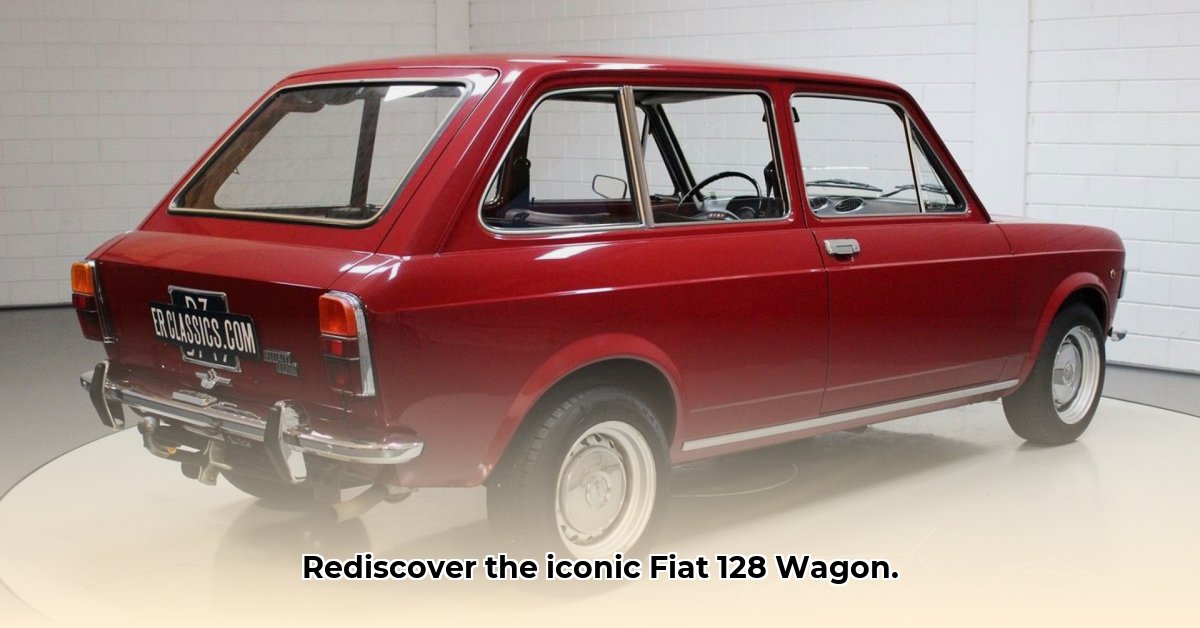
The Fiat 128 wagon, a seemingly unassuming compact car from the late 1960s, quietly revolutionized automotive design. This wasn't your grandfather's station wagon; it was a cleverly engineered marvel of space optimization and forward-thinking design that continues to influence car manufacturing today. Its compact size belied a surprisingly spacious interior and a pioneering engineering approach that cemented its place in automotive history. Let's delve into the details of this Italian icon.
The Revolutionary Transverse Engine and Front-Wheel Drive
Unlike its contemporaries, which largely adhered to traditional rear-wheel-drive layouts, the Fiat 128 dared to be different. Its engineers boldly placed the engine transversely—across the car, rather than lengthwise—and coupled it with front-wheel drive. This seemingly minor alteration had profound consequences.
Why was this such a big deal? Most compact cars of the era struggled to balance interior space with engine placement. Rear-wheel-drive layouts often resulted in cramped passenger compartments. The Fiat 128’s transverse engine, however, freed up significant space, creating a surprisingly roomier cabin and a generous cargo area—a remarkable feat in a car of its size. This innovative design wasn't just about comfort; it also reduced manufacturing costs by simplifying assembly.
But the impact extended beyond mere practicality. The front-wheel-drive system, uncommon for cars of this size at the time, proved to be highly efficient and offered unexpectedly good handling. This bold move wasn't just innovative; it was prescient, paving the way for front-wheel drive to become the dominant configuration in smaller passenger cars worldwide. Wasn't this a stroke of genius?
Beyond Engineering: A Family of Fiat 128s
The Fiat 128 wasn't confined to a single body style. Fiat cleverly offered the platform in a range of variations—a sedan, a sporty coupe, and even a small pickup truck. This versatile approach appealed to a broad spectrum of consumers, showcasing the platform's adaptability. This strategic diversification undoubtedly contributed to the staggering sales figures: over three million Fiat 128s and its variants were sold globally. This success wasn't just a testament to its engineering prowess; it was a validation of Fiat's shrewd marketing and recognition of diverse consumer needs.
This versatility, coupled with its fuel efficiency (a crucial factor considering the fluctuating oil prices of the era), helped the Fiat 128 achieve phenomenal commercial success. The car's groundbreaking design even garnered prestigious recognition, winning the European Car of the Year award in 1970–a significant achievement.
A Lasting Legacy: The Fiat 128's Enduring Influence
The Fiat 128 wagon wasn't simply a successful car; it was a pivotal moment in automotive history. While its smaller engines (1.1-liter or 1.3-liter four-cylinder options) might seem underpowered by today's standards, it was perfectly suited to the market and its emphasis on fuel efficiency and affordability. Ultimately, changing consumer preferences and increased competition led to the cessation of its original production run in 1985, though licensed production continued for a time overseas.
Yet, its innovative transverse engine and front-wheel-drive configuration continue to resonate in modern automotive design. The space-saving and manufacturing efficiencies it pioneered are now industry standards, found in countless vehicles today. The Fiat 128 wagon serves as a powerful reminder that even small cars can have a monumental impact on the automotive landscape, leaving a legacy of innovation that continues to inspire.
The Fiat 128 Wagon: Key Specifications
| Feature | Details |
|---|---|
| Engine Options | 1.1L and 1.3L inline-four cylinder engines |
| Drive Type | Front-wheel drive (FWD) |
| Body Styles | Sedan, Station Wagon (Fiat 128 Wagon), Coupé, Compact Pickup Truck |
| Production | 1969-1985 (original production); licensed production continued elsewhere |
| Key Innovation | Transversely mounted engine and front-wheel-drive configuration |
| Lasting Impact | Profound influence on small-car design globally |
Key Takeaways:
- The Fiat 128 wagon’s innovative transverse engine and front-wheel-drive system revolutionized small-car design.
- Its versatile body styles broadened its appeal and contributed to its immense sales success.
- The Fiat 128’s influence on modern automotive design is undeniable, with its space-saving and cost-effective engineering principles still widely adopted today.